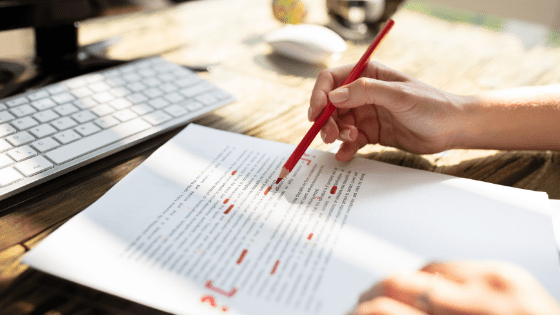Everyone knows what proofreading is. Simply put, proofreading is that fresh coat of paint at the end of your project, that final layer of polish you apply to ensure there are no glaring mistakes in your work. Right? Maybe not…
Of course, you absolutely want to give your work a careful final reading before submitting a grant application. You are sure to turn off any grant reviewer with erroneous information or silly grammatical mistakes—and there are many great tricks and tools you can use to root out those nasty little flaws. But one of the most widely perpetuated misconceptions about proofreading is that it’s simply the final quality check before wrapping up your proposal, putting a bow on it, and sending it off to a funder.
Rather than saving it all for the end, the best approach to quality proofreading is to proofread throughout the creation of your proposals. Don’t count on yourself to catch all the mistakes in a single sweep at the end! Grant applications, by nature, involve the assembly of many pieces, some of which are being edited as you assemble the proposal. Instead of waiting until they all converge to examine them, it’s wise to first review them as isolated components.
As you proof your work, whether it be the first, second, or seventh reading, remember that you’re doing more than just weeding out typos. Proof for cohesion, so that all those previously separate components have been woven together. Proof for accuracy to ensure that you aren’t submitting outdated or incorrect information. Proof for precision to make sure you say everything you need to say without surpassing any word or character restrictions. Finally, proof for readability—because if you’re bored or confused by your own writing, however technically correct it may be, then you can rest assured that anyone reviewing your application will be doubly bored or confused.
Naturally, proofing one’s own work with a sharp, objective eye presents a challenge of its own. Perhaps you are quick to forgive your problematic writing by labeling it as a “stylistic choice,” or maybe you’re overly critical of your own work and spend too much time sweating out the minutia. Either way, here are a few methods you can use to help compensate for your own humanity:
- Proofread by reading your entire application in reverse: Go to the bottom of your application and read the final sentence. Then read the sentence above it. Continue upward, reading your entire application in this way. This backwards process helps your brain pick up on some issues that it may automatically gloss over on a typical reading.
- Get fresh eyes on your work! If you can ask a colleague to review your work, their distance from your project can produce excellent insight. If you work alone, and if the deadline is not too close, sometimes it’s best to set your proposal down and conduct your proofing session the next day.
- Use a grammar checker. Many word processors come with built-in checkers that point out grammatical and syntactical errors. You can also find plenty of free grammar checker applications and web browser extensions that do a thorough job.
- Do a final check on any file uploads or attachments you will be submitting with your application. Make sure the file names conform to any formatting requirements. Also proof the attachments themselves to make sure they are from the proper year, contain the necessary information (including signatures), and that they are indeed the type of files requested by the funder. Double check your math and formulas for any budgets that are submitted.
Ultimately, writing and proofreading share this cardinal rule: Remember your audience. No matter the funder, and no matter their priorities, the person reviewing the fruits of your labor is still a person! You never know what kind of headspace that person will be in when they first lay eyes on your application. Maybe they will have just arrived at the office after a particularly dreadful commute, or they spilled their coffee on their shirt, or maybe they’ll have had a rough night’s sleep.
Do them the kindness of submitting work that is as clean and airtight as possible, and in return you can expect a much kinder reading of your proposal.
By Tim Hausler, Proposal Writer


